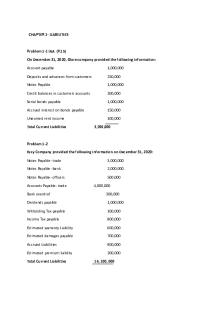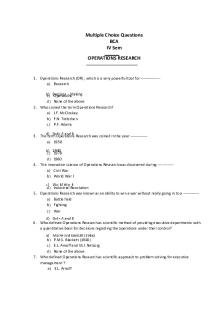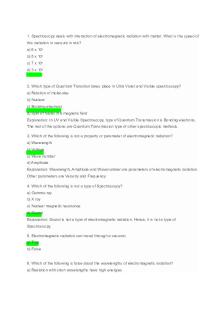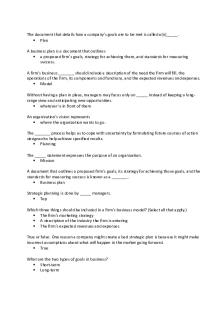MCQ module 1 - none PDF

| Title | MCQ module 1 - none |
|---|---|
| Author | DIVYA TRIPATHY |
| Course | CSE |
| Institution | Bennett College |
| Pages | 13 |
| File Size | 361.3 KB |
| File Type | |
| Total Downloads | 10 |
| Total Views | 153 |
Summary
none...
Description
1. Spectroscopy deals with interaction of electromagnetic radiation with matter. What is the speed of this radiation in vacuum in m/s? a) 6 x 108 b) 5 x 108 c) 7 x 108 d) 3 x 108
2. Which type of Quantum Transition takes place in Ultra Violet and Visible spectroscopy? a) Rotation of molecules b) Nuclear c) Bonding electrons d) Spin of nuclei in a magnetic field Explanation: In UV and Visible Spectroscopy, type of Quantum Transmission is Bonding electrons. The rest of the options are Quantum Transmission type of other spectroscopic methods. 3. Which of the following is not a property or parameter of electromagnetic radiation? a) Wavelength b) Voltage c) Wave number d) Amplitude Explanation: Wavelength, Amplitude and Wavenumber are parameters of electromagnetic radiation. Other parameters are Velocity and Frequency. 4. Which of the following is not a type of Spectroscopy? a) Gamma ray b) X ray c) Nuclear magnetic resonance d) Sound Explanation: Sound is not a type of electromagnetic radiation. Hence, it is not a type of Spectroscopy. 5. Electromagnetic radiation can travel through a vacuum. a) Transparent medium b) opaque medium c) vacuum d) both a and c
. 6. Which of the following is false about the wavelengths of electromagnetic radiation? a) Radiation with short wavelengths have high energies b) Energy does not depend on wavelength c) Radiation with long wavelengths have low energies d) Energy depends on wavelength . 7. Which of the following is the wavelength of microwave radiation? a) 10 – 780nm b) 0.78 – 30µm c) 0.6 – 10 m d) 0.75 – 3.75 mm
8. How is the wave number of electromagnetic radiation related to wavelength? a) It is the reciprocal of wavelength b) It is directly proportional to wavelength c) It is not related to wavelength d) It is equal to wavelength. 9. Which of the following is the wavenumber of UV and Visible radiation? a) 1 x 106 to 1.3 x 104 m-1 b) 1 x 106 to 1.3 x 104 m c) 13 – 27 m-1 d) 1 x 106 to 1.3 x 104 m2 .10. Velocity of electromagnetic radiation is more in a vacuum than in any medium. a) True b) False 11. What type of energy can you can sense with your eyes?
Sound Energy Light Energy Electric Energy Thermal Energy
12. What happens when light waves bounce off the surface of an object?
Transmission Absorption Reflection Refraction 13. What happens when light energy bends as it passes from one type of substance to another type?
Transmission Absorption Refraction Reflection 14. What happens when light energy passes straight through an object?
Reflection Refraction Absorption Transmission 15. What happens when light energy is stopped by and object and soaks in?
Reflection Refraction Absorption
Transmission 16. How does light travel?
Light does not travel By reflecting through space until it is transmitted By refracting through space until it is absorbed In a straight line until it hits an object 17. Which objects refract light energy?
Shiny object, lens, and mirror Lens, prism, and passing through water Lens, prism, and mirror Mirror, lens, and passing through water 18. Which objects reflect light energy?
Mirror, shiny, smooth objects, and the surface of water Lens, prism, and mirror Mirror, lens, and water Lens, prism, and water
19. Light rays are disappearing into a surface. What is happening to the light rays? Refraction Reflection
Transmission Absorption 20. Light rays are passing through a window. What is happening to the light rays?
Transmission Reflection Absorption Refraction 21. When you look in a mirror, which of the following causes your eye to be able to see your image?
Transmission Absorption Reflection Refraction 22. Which of the following causes a straw in a glass to appear broken and bent?
Absorption Tranmission Reflection Refraction
23. What happens to light passing through a hand lens that makes the image of a penny appear larger?
Reflection Transmisson Absorption Refraction
24. An image can be seen in a shiny surface when light is –
Reflected Absorbed Refracted Transmitted 25. Which of the following materials would reflect the most light?
A dark brown carpet square. A flat sheet of aluminum foil. A piece of red construction paper. A bumpy, black rock. 26. Which of these best explains why a student can see her reflection in a computer screen when the screen is turned off?
Computers produce light when they are being used. The glass allows light to be transmitted through it. Smooth, shiny objects reflect a great amount of light. Black objects absorb most of the light striking them.
27. A student sees a mirror image of a tree in a pond on a very still day. The student is able to see a mirror image of the tree in the pond because light striking the surface of the water – is absorbed. bends downward. becomes brighter. bounces off. 28. A light ray is traveling through air. When it enters water, it slows and bends. What is this change in direction called?
Tranmission Absorption Reflection Refraction 29. Light is hitting the pavement and disappears. The pavement is getting hot. What is this an example of?
Refraction Reflection Absorption Transmission 30. What might explain why light travels in a straight line?
If there is nothing to interfere with light waves, they will travel in a straight line. Light waves travel in a straight line because sound waves travel in a straight line.
Light waves will always travel in a straight line, even if they come into contact with another object. Light waves don’t travel in a straight line.
31. Fluorescence occurs when... a) A molecule returns to the electronic ground state from an excited triplet state by losing it's excess energy as a photon b) A molecule returns to the electronic ground state from an excited singlet state by losing it's excess energy as a photon c) A molecule lowers its vibrational energy by losing it's excess energy as a photon Answer:
c
32. Internal conversion is where... a) The spin of an excited electron reverses, changing the state of the molecule (from singlet state to triplet state or vice versa) b) A molecule converts its excess energy to light, and emits a photon c) A molecule converts excess electronic energy to vibrational energy Answer:
a
33. Intersystem crossing is where... a) The spin of an excited electron reverses, changing the state of the molecule (from singlet state to triplet state or vice versa) b) A molecule converts its excess energy to light, and emits a photon c) A molecule converts excess electronic energy to vibrational energy Answer:
c
33. Phosphorescent emission of light can persist after the radiation used to excite the molecules has been turned off. True or false? True
Answer:
”. 34. Which of the following is not a type of radiation detectors? a) Geiger Muller counter b) Scintillators c) Semiconductor detector d) Flame emission detector . 35. ‘When nuclear radiations pass through, gas ionization is produced.’ This is the principle of which of the following detectors? a) Proportional counter b) Flow counter c) Geiger Muller counter d) Scintillation counter
Explanation: ‘When nuclear radiations pass through, gas ionization is produced.’ This is the principle of which of Geiger Muller counter. It is used to measure the intensity of radioactive radiation.
36. Which of the following acts as quenching gas in Geiger Muller counter? a) Alcohol b) Argon gas c) Krypton d) Hydrogen
Explanation: Alcohol acts as quenching gas in Geiger Muller counter. It is present in a gas tight envelope along with the electrodes.
37. Which of the following acts as ionising gas in Geiger Muller counter? a) Alcohol b) Argon gas c) Krypton d) Hydrogen Explanation: Argon gas acts as ionising gas in Geiger Muller counter. It is present in a gas type envelope along with the electrodes.
38. Which of the detectors is similar to Geiger Muller counter in construction but is filled with heavier gas? a) Proportional counter b) Flow counter c) Semiconductor detector d) Scintillation counter Explanation: Proportional counter is similar to Geiger Muller counter in construction but is filled with heavier gas. The output is proportional to the intensity of radiation incident on it. 39. Which of the following gases are used in the proportional counter as the ionising gas? a) Alcohol b) Argon gas c) Krypton d) Hydrogen Explanation: Proportional counter is filled with krypton. It acts as ionising gas. Xenon can also be used. 40. Which of the following is the main disadvantage of solid state semiconductor detector? a) Low accuracy b) Low sensitivity c) It should be maintained at low temperature d) High pressure has to be produced Explanation: The main disadvantage of solid state semiconductor detector is that it must be maintained at low temperature. This is necessary to reduce noise and to prevent deterioration of detector characteristics. 41. Scintillation detector is a large flat crystal of which of the following materials? a) Sodium chloride b) Sodium iodide c) Sodium sulphate d) Sodium carbonate Explanation: Scintillation detector is a large flat crystal of sodium iodide. It is coated with thallium doping.
42. When X-ray enters the solid state detector it produces ion pair rather than electron-hole pair. a) True b) False
Explanation: When X-ray enters the solid state detector it produces electron-hole pair rather than an ion pair. The output signal is taken from an aluminium layer. 43. Which of the following materials are used as the insulation between the inner and outer electrodes of the ion chamber? a) Polythene b) Plastic c) Polytetrafluoroethylene d) Polyacrylamide
Explanation: Polytetrafluoroethylene is used as the insulation between the inner and outer electrodes of the ion chamber. The material has very high resistance. 44.. Liquid samples must be counted using ionization chamber by placing them in which of the following? a) Test tube b) Curvette c) Ampoules d) Flask
Explanation: Liquid samples must be counted using ionization chamber by placing them in ampoules. The ampoules are placed in the chamber. 45. Gaseous compounds containing radioactive sources can be directly introduced into the ionization chamber. a) True b) False
Explanation: Gaseous compounds containing radioactive sources can be directly introduced into the ionization chamber. Liquid samples cannot be introduced directly. advertisement 46. Liquid Scintillators are used for which of the following materials? a) Low energy beta materials b) High energy beta materials c) Low energy gamma materials
d) High energy gamma materials Explanation: Liquid Scintillators are used for low energy beta materials. Solid scintillators are used for high energy beta materials. 47. Given below is the block diagram of proportional counter. Identify the unmarked component.
a) Collimator b) Detector crystal c) Pre-amplifier d) Position logic circuit Explanation: The unmarked component is pre-amplifier. There are two amplifiers namely preamplifier and main amplifier. 48. Given below is a diagram of Scintillation detector. Identify the unmarked component.
a) Lens b) Collimator c) Dynodes d) Focussing cup
Explanation: The unmarked components are dynodes. Scintillation detector is a combination of scintillator and photo multiplier tube....
Similar Free PDFs

MCQ module 1 - none
- 13 Pages

Trends Q2 Module 2 - NONE
- 32 Pages

MCQ 1 - MCQ 1
- 4 Pages

Chapter 1-9 - NONE
- 33 Pages

3-3-1 - none
- 1 Pages

Chapter 1 lecture - none
- 3 Pages

Chapter 1 - none
- 5 Pages

Chapter 1 MCQ - Practice MCQ
- 22 Pages

Acyclovir - none
- 3 Pages

MCQ 1
- 13 Pages

Task 1-QBM1 D081 - none
- 2 Pages

L01 - None
- 3 Pages

8 - None
- 16 Pages

Module-1 ACA - module 1
- 42 Pages

MAN5 - none
- 4 Pages
Popular Institutions
- Tinajero National High School - Annex
- Politeknik Caltex Riau
- Yokohama City University
- SGT University
- University of Al-Qadisiyah
- Divine Word College of Vigan
- Techniek College Rotterdam
- Universidade de Santiago
- Universiti Teknologi MARA Cawangan Johor Kampus Pasir Gudang
- Poltekkes Kemenkes Yogyakarta
- Baguio City National High School
- Colegio san marcos
- preparatoria uno
- Centro de Bachillerato Tecnológico Industrial y de Servicios No. 107
- Dalian Maritime University
- Quang Trung Secondary School
- Colegio Tecnológico en Informática
- Corporación Regional de Educación Superior
- Grupo CEDVA
- Dar Al Uloom University
- Centro de Estudios Preuniversitarios de la Universidad Nacional de Ingeniería
- 上智大学
- Aakash International School, Nuna Majara
- San Felipe Neri Catholic School
- Kang Chiao International School - New Taipei City
- Misamis Occidental National High School
- Institución Educativa Escuela Normal Juan Ladrilleros
- Kolehiyo ng Pantukan
- Batanes State College
- Instituto Continental
- Sekolah Menengah Kejuruan Kesehatan Kaltara (Tarakan)
- Colegio de La Inmaculada Concepcion - Cebu
